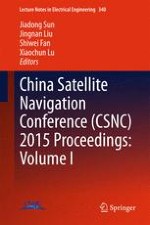2015 | OriginalPaper | Buchkapitel
65. Feasibility Analysis of GNSS Multi-constellation Positioning for Lunar Spacecraft
verfasst von : Lei Chen, Yangbo Huang, Wenxiang Liu, Gang Ou
Erschienen in: China Satellite Navigation Conference (CSNC) 2015 Proceedings: Volume I
Verlag: Springer Berlin Heidelberg
Aktivieren Sie unsere intelligente Suche, um passende Fachinhalte oder Patente zu finden.
Wählen Sie Textabschnitte aus um mit Künstlicher Intelligenz passenden Patente zu finden. powered by
Markieren Sie Textabschnitte, um KI-gestützt weitere passende Inhalte zu finden. powered by
